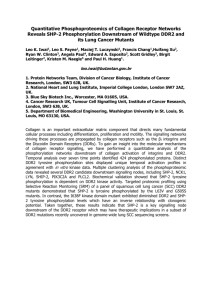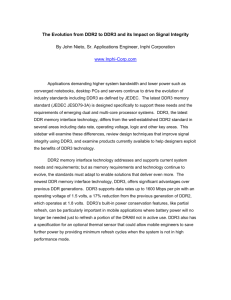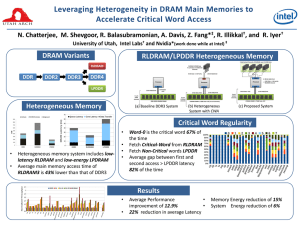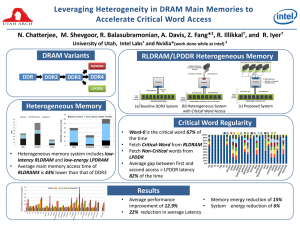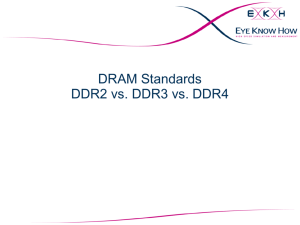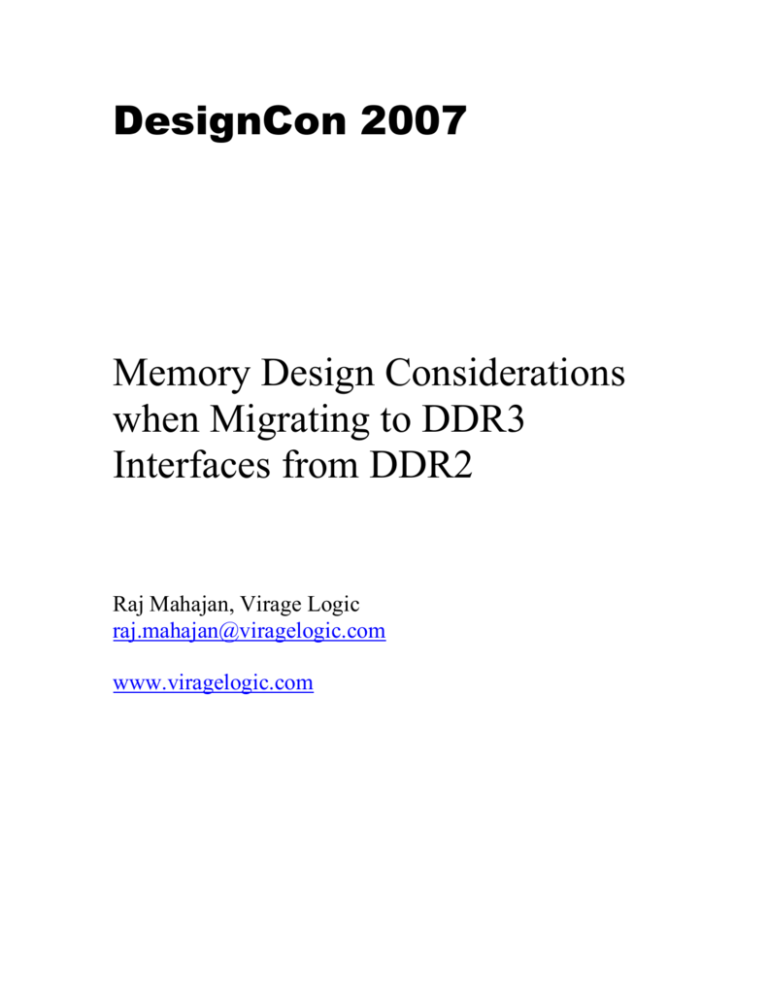
DesignCon 2007
Memory Design Considerations
when Migrating to DDR3
Interfaces from DDR2
Raj Mahajan, Virage Logic
raj.mahajan@viragelogic.com
www.viragelogic.com
Abstract
The emerging DDR3 memory standard will extend the performance range of DDR
memories considerably, while maintaining some amount of backwards compatibility with
the existing DDR2 memory standard. It is important to understand the similarities and
differences between the DDR3 standard and the existing DDR2 standard in order to get
the maximum benefit from the new standard while re-using as much as possible from any
previous DDR2 memory interface design. This paper will provide the reader with a
detailed understanding of the key design considerations when migrating to a DDR3
system interface from a DDR2 interface.
This paper will review the new DDR3 features and compare and contrast them to
previous features available in the DDR2 specification. One of the biggest changes is the
in Physical Layer (PHY) portion of the memory interface and these changes will be highlighted and illustrated with an example design of a high performance processor interface.
The areas where backwards compatibility should be maintained will also be illustrated
with an example design, showing how simple changes can provide significant benefits in
re-use and system flexibility. For more information visit www.memcoreinc.com.
Author(s) Biography
Raj Mahajan has more than 10 years of experience architecting, designing, and verifying
memory access solutions for advanced ASICs for a variety of target markets. He started
his career at Intel Corp, where he architected and designed advanced render cache
controllers that shipped hundreds of millions of units in several generations of graphicsenabled PC chipsets. Following that he held a lead design position at 2Wire, Inc., a
successful start-up addressing the residential broadband access market, where he led the
integration and verification of their flagship SoC, which shipped first silicon. At startup
Ingot Systems he led the architecture, design, and verification of subsidiary MemCore
Inc.'s flagship memory controller, leading to the successful sale of the company to Virage
Logic in 2007. He continues his work leading the development of this IP, branded as
"IntelliDDR", at Virage Logic.
Introduction
The emerging DDR3 memory standard will extend the performance range of DDR
memories considerably, while maintaining some amount of backwards compatibility with
the existing DDR2 memory standard. It is important to understand the similarities and
differences between the DDR3 standard and the existing DDR2 standard in order to get
the maximum benefit from the new standard while re-using as much as possible from any
previous DDR2 memory interface design. This paper will provide the reader with a
detailed understanding of the key design considerations when migrating to a DDR3
system interface from a DDR2 interface.
A Comparison of DDR2 and DDR3 Memory Standards
The DDR2 memory standard is being upgraded with the advent of the DDR3 standard.
The variety of memory devices available today provides the system architect with
multiple options when selecting a memory. Before going into the detailed comparison of
DDR2 and DDR3 let’s review the key features of a typical DDR2 memory subsystem and
the associated memory controller. This will serve as a baseline for the detailed
comparison.
DDR2 Description
A typical DDR2 memory subsystem uses a DIMM to house multiple DDR2 memory
devices. A typical DDR2 DIMM architecture is illustrated in Figure 1 below. The control
and address signals come onto the DIMM and are routed to the memory devices in a Tbranch topology. This architecture balances the delay to each memory device, but
introduces additional skew due to the multiple stubs and the stub length.
UDIMM Module
CS/Address/CTRL
Figure 1: DDR2 Memory Module Architecture
A DDR2 memory controller is located on the chip driving the DIMM module. A typical
DDR2 memory controller is show in the block diagram in Figure 2. The PHY is
responsible for the physical interface between the DDR DRAM and the rest of the
system. Timing is controlled precisely to insure data is captured or presented in just the
right relationship with the DRAM clocking signals. Data read from the DRAM is
optionally corrected by the ECC block and then provided to the pending write and read
modify write FIFO. If ECC is being used, the ECC check bits are computed prior to the
write to memory by another optional ECC block in the write path.
Command
BE
Open Page Number
by Bank
PI
IH
NT
FIFO
Pending
Transaction
Meta Data
Selected Bank
Transaction
Bank State
Machine
BSM
OS
GS
PHY
Data for Write
Transactions
MR
FIFO
ECC
WU
RT
Response
Byte Enables
RA
ECC
Figure 2: DDR2 Functional Block Diagram
The scheduler prioritizes the current list of commands and determines which command is
the most urgent and issues that command to the DRAM. Data is read or written to the
memory based on the scheduler’s computation of access priority. The scheduler
constantly works towards the goal of maximizing overall system bandwidth while issuing
all high priority command as quickly as possible.
Commands are optionally pipelined and added to the pending FIFO. If the command is
most urgent (direct read) it bypasses the pending FIFO and is issued directly to the
memory. Regular priority accesses make their way through the pending read FIFO or the
read token FIFO for command completion.
DDR3 Description
The main thrust of the DDR3 memory standard is to increase bandwidth while making it
relatively easy for the designer to take advantage of this bandwidth increase. Innovations
in the physical layer (PHY) portion of the DDR3 interface support this increase in
bandwidth. One of these innovations is the use of a Leveling technique that adjusts for
the delay between DDR3 memories.
The DDR3 specification can support a fly-by architecture either on a memory module or
on a board. In this architecture, illustrated in Figure 3 below, the signals from the
memory controller are connected in series to each memory component. In this example, a
memory module, the signals from the DDR3 PHY come into the middle of the module
and connect to each memory chip sequentially. This reduced the number of stubs and the
stub lengths. Termination is placed just at the end of the signal. This improves the signal
characteristics over the traditional DDR2 topology.
UDIMM Module
T
CS/Address/CTRL
Figure 3: Fly-by Topology for DDR3 Unbuffered DIMM
The draw-back to this approach is that the delay from the PHY output signals to each
memory is slightly different, depending on where the memory chip is in the sequence.
This delay difference needs to be compensated for by the DDR3 PHY and uses the new
Leveling feature required by the DDR3 specification. There is a different technique for
both write and read leveling.
Write Leveling
During Write Leveling the memory controller needs to compensate for the additional
flight time skew delay introduced by the fly-by topology with respect to strobe and clock.
In particular, the tDQSS, tDSS and tDSH timing requirements would be very difficult to
meet. These timing parameters can be met by using a programmable delay element on
DQS with fine enough granularity so that the proper delay can be inserted to compensate
for the additional skew delay. The figure below shows the needed timing relationship.
The source CK and DQS signals are delayed in getting to the destination as illustrated by
arrow #1 and arrow #2 respectively. (This delay can be different for each memory
component on the memory module and will be adjusted on a chip by chip basis and even
on a byte basis if the chip has more than one byte of data. The diagram illustrates just one
instance of a memory component). The memory controller repeatedly delays DQS, a step
at a time, until a transition from a zero to a one is detected on the destination CK signal.
This will re-align DQS and CL so that the destination data on the DQ bus can be captured
reliably. Because all this is done automatically by the controller the board designer need
not worry about the details of the implementation- he or she just benefits from the
additional margin created by the Write Leveling feature in the DDR3 memory controller.
Source
diff_CK
diff_DQS
#1
#2
Destination
diff_CK
diff_DQS
#4
DQ
Delay DQS
X
0
0
#3
Figure 4. Timing Diagram for Write Leveling
Read Leveling
During Read Leveling the memory controller adjusts for the delays introduced by the flyby memory topology that impact the read cycle. This is done via the addition of a special
Multi-Purpose Register (MPR) in the DDR3 memory device. The MPR can be loaded
with predefined data values via a special command from the memory controller. These
data values can be used for system timing calibration by the memory controller.
As shown in Figure 5 below, the MPR can be selected, by setting a bit in another memory
register (EMRS3, bit A2), to switch the source of data for memory read to come from the
MPR, not the normal memory array. The MPR data is substituted for the DQ, DM, DQS
and /DQS pads on the memory device. This feature allows the memory controller to
calibrate the timing of the read path to adjust for any additional delays introduced by the
DDR3 fly-by architecture.
Memory
Array
Switch
MPR
DQ, DM, DQS, /DQS Pads
Figure 5. Read Leveling Using MPR
Other DDR3 Features
DDR3 has additional features to improve performance and reliability. These include a
Reset pin, an 8-bit pre-fetch, and ZQ calibration. A new Reset pin is used to clear all state
information in the DDR3 memory device without the need to individually reset each
control register or power down the device. This saves time and power when bringing the
device to a known state. The 8-bit pre-fetch is used in conjunction with burst length of 4
or 8. This improves performance for sequential accesses. The new ZQ calibration feature
allows the memory device to take a longer time for calibration at start-up and a smaller
time during periodic calibration activities. The table below shows a feature by feature
comparison of DDR, DDR2 and DDR3 memory devices.
Data Rate
Interface
Source Sync
Burst Length
CL/tRCD/tRP
Reset
ODT
Driver Calibration
Leveling
DDR
200-400Mbps
SSTL_2
DDR2
400-800Mbps
SSTL_18
Bi-directional DQS
(Single ended
default)
BL= 2, 4, 8
(2bit prefetch)
15ns each
No
No
Bi-directional DQS
(Single/Diff Option)
BL= 4, 8
(4bit prefetch)
15ns each
No
Yes
No
No
Off-Chip
No
DDR3
800-1600Mbps
SSTL_15
Bi-directional DQS
(Differential
default)
BL= 4, 8
(8bit prefetch)
12ns each
Yes
Yes
On-Chip with ZQ
pin
Yes
Table 1: DDR, DDR2 and DDR3 Feature Comparison
Planning For Migration- an Example Design
In order to explore how to prepare a DDR2 design for migration to a DDR3 design it will
help to establish an example system. Let’s assume that the system will require a DIMM
interface for DDR2 and will want to use a similar type of memory module in the DDR3
implementation. Performance is increasingly important for many applications so the
decision is to initially design the controller as a DDR2 design, but to allow future
migration to DDR3. As much as possible, we want to make it easy to modify the board
and the memory controller to migrate from the DDR2 implementation to DDR3.
Board Level Issues
One of the biggest issues when thinking of migrating from DDR2 to DDR3 is that the
DIMM have different pin-outs and sizes. This means that it will be very difficult, at the
board level to just plug in a new memory module. The best you can hope for is to take
into account some of the other key characteristics and make it easy to spin the board for a
DDR3 module. Probably the most important items to take care of at the board level will
be DQS, the Reset pin.
DQS
In DDR3 DQS is specified as differential while in DDR2 it can be single ended or
optionally differential. Clearly if the differential version is used in DDR2 it will make the
transition to DDR3 easier. This may require additional pins in the memory controller, but
if upward compatibility is important the extra pins will be worth it. Your DDR2
implementation will be more robust as well.
In DDR3 the DQS is sourced by each memory device in order to account for the
additional delay from the fly-by topology. The number of DQS signals is thus larger in
the DDR3 implementation that the DDR2 version. Again, if the additional pins are not a
big issue it will help with the migration to DDR3 to implement the additional DQS
signals in the DDR2 implementation.
Reset
The Reset pin present in DDR3 would be easy to add to DDR2. The pin wouldn’t do
anything in the DDR2 implementation, but including it would insure that the pin is
available when its time to migrate to DDR3.
Memory Controller Issues
Other aspects of the DDR2 to DDR3 migration will require some impact to the memory
controller. If the DDR2 memory controller is designed with some of these issues in mind
it can simplify the process considerably. Some of the most important issues are the output
drivers, DLLs for write launch, and Read Leveling.
Output Drivers
The DDR2 standard calls for 1.8V SSTL IOs. DDR3 calls for 1.5V SSTL IOs. It may be
difficult to find an IO buffer that can support both standards. It might require a
programmable IO, similar to those found on FPGAs, to support both standards. A change
in IO buffers would require a spin of the chip driving the DDR3 memory, but perhaps a
metal mask option could be used to make this change less expensive.
DLLs for Write Launch
Typical DDR2 memory controllers can get away with one DLL for several data outputs.
In DDR3, due to the fly-by topology, it will be more usual to see a DDL for every 8-bits
or so. This would require a larger number of DLL to be included in the DDR2 design in
order to provide the resources required for the DDR3 migration. A digital DLL
implementation can be very compact in die size and can minimize the overhead
associated with the DDR3 requirement.
Read Leveling
Typical DDR2 memory controllers use an extra pair of IO pins to calibrate the controller
read timing. These pins are used to help adjust the incoming data with respect to the
strobe. Other controllers use a training sequence by writing and reading data from
memory and adjusting the strobe to optimize the data capture point. In DDR3 the Read
Leveling feature is used to do this and requires no additional pins. If the memory
controller can be designed to include the Read Leveling feature, even if not use din
DDR2, it would help with DDR3 migration.
Conclusion
DDR3 offers a substantial performance improvement over previous DDR2 memory
systems. New DDR3 features, all transparently implemented in the memory controller,
improve the signal integrity characteristics of DDR3 designs so that higher performance
is achieved without an undue burden for the system designer. If proper consideration is
given to any new DDR2 memory design, it can be a relatively easy upgrade to support
DDR3 in the next generation design. This paper identified the key differences between
DDR2 and DDR3 and illustrated some of the key issues that need to be addressed to easy
migration to DDR3.
© 2008 Virage Logic Corporation. All rights reserved.

